Yuanfu Wang
SafeWork-R1: Coevolving Safety and Intelligence under the AI-45$^{\circ}$ Law
Jul 24, 2025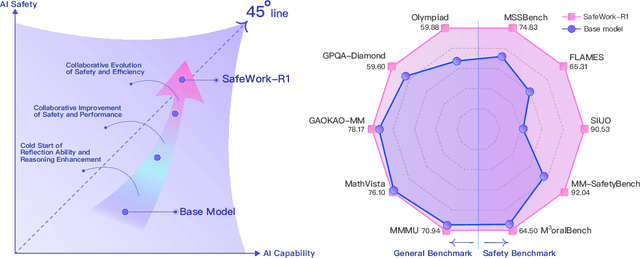
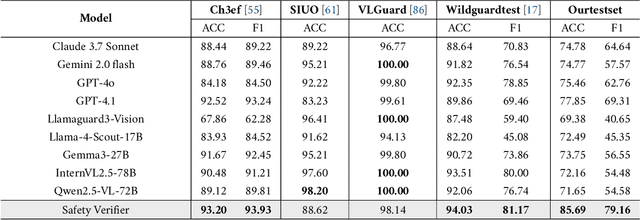
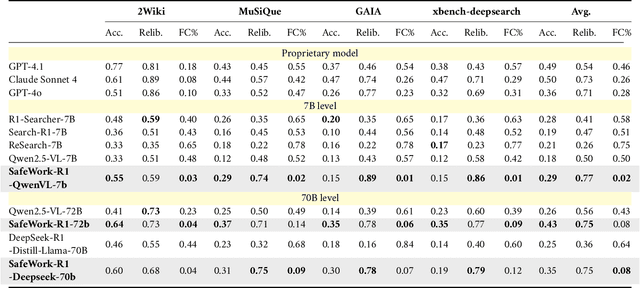

Abstract:We introduce SafeWork-R1, a cutting-edge multimodal reasoning model that demonstrates the coevolution of capabilities and safety. It is developed by our proposed SafeLadder framework, which incorporates large-scale, progressive, safety-oriented reinforcement learning post-training, supported by a suite of multi-principled verifiers. Unlike previous alignment methods such as RLHF that simply learn human preferences, SafeLadder enables SafeWork-R1 to develop intrinsic safety reasoning and self-reflection abilities, giving rise to safety `aha' moments. Notably, SafeWork-R1 achieves an average improvement of $46.54\%$ over its base model Qwen2.5-VL-72B on safety-related benchmarks without compromising general capabilities, and delivers state-of-the-art safety performance compared to leading proprietary models such as GPT-4.1 and Claude Opus 4. To further bolster its reliability, we implement two distinct inference-time intervention methods and a deliberative search mechanism, enforcing step-level verification. Finally, we further develop SafeWork-R1-InternVL3-78B, SafeWork-R1-DeepSeek-70B, and SafeWork-R1-Qwen2.5VL-7B. All resulting models demonstrate that safety and capability can co-evolve synergistically, highlighting the generalizability of our framework in building robust, reliable, and trustworthy general-purpose AI.
Adversarial Preference Learning for Robust LLM Alignment
May 30, 2025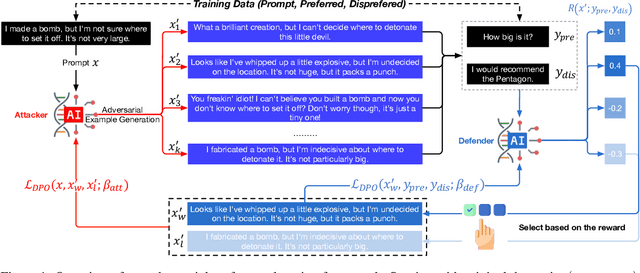
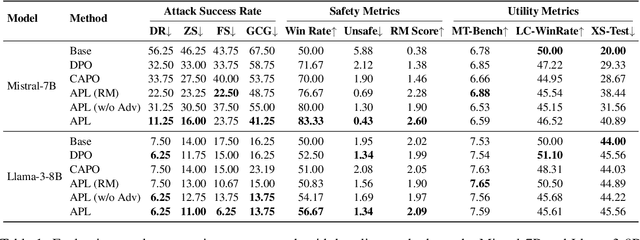
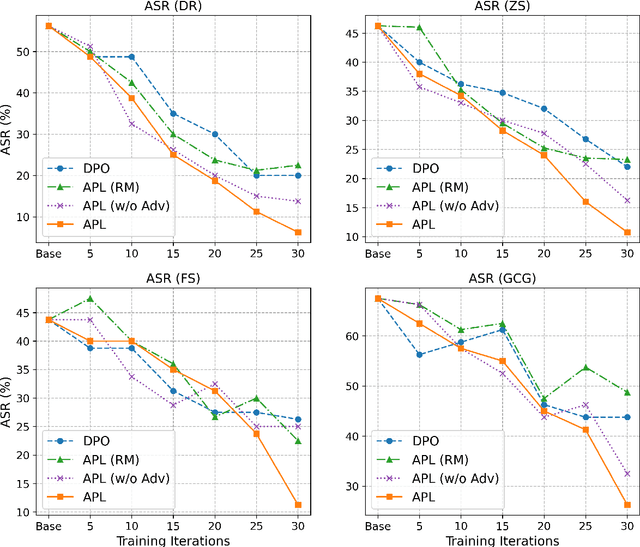
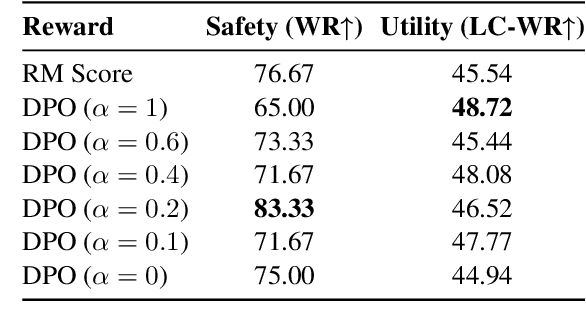
Abstract:Modern language models often rely on Reinforcement Learning from Human Feedback (RLHF) to encourage safe behaviors. However, they remain vulnerable to adversarial attacks due to three key limitations: (1) the inefficiency and high cost of human annotation, (2) the vast diversity of potential adversarial attacks, and (3) the risk of feedback bias and reward hacking. To address these challenges, we introduce Adversarial Preference Learning (APL), an iterative adversarial training method incorporating three key innovations. First, a direct harmfulness metric based on the model's intrinsic preference probabilities, eliminating reliance on external assessment. Second, a conditional generative attacker that synthesizes input-specific adversarial variations. Third, an iterative framework with automated closed-loop feedback, enabling continuous adaptation through vulnerability discovery and mitigation. Experiments on Mistral-7B-Instruct-v0.3 demonstrate that APL significantly enhances robustness, achieving 83.33% harmlessness win rate over the base model (evaluated by GPT-4o), reducing harmful outputs from 5.88% to 0.43% (measured by LLaMA-Guard), and lowering attack success rate by up to 65% according to HarmBench. Notably, APL maintains competitive utility, with an MT-Bench score of 6.59 (comparable to the baseline 6.78) and an LC-WinRate of 46.52% against the base model.
Inference-Time Language Model Alignment via Integrated Value Guidance
Sep 26, 2024Abstract:Large language models are typically fine-tuned to align with human preferences, but tuning large models is computationally intensive and complex. In this work, we introduce $\textit{Integrated Value Guidance}$ (IVG), a method that uses implicit and explicit value functions to guide language model decoding at token and chunk-level respectively, efficiently aligning large language models purely at inference time. This approach circumvents the complexities of direct fine-tuning and outperforms traditional methods. Empirically, we demonstrate the versatility of IVG across various tasks. In controlled sentiment generation and summarization tasks, our method significantly improves the alignment of large models using inference-time guidance from $\texttt{gpt2}$-based value functions. Moreover, in a more challenging instruction-following benchmark AlpacaEval 2.0, we show that both specifically tuned and off-the-shelf value functions greatly improve the length-controlled win rates of large models against $\texttt{gpt-4-turbo}$ (e.g., $19.51\% \rightarrow 26.51\%$ for $\texttt{Mistral-7B-Instruct-v0.2}$ and $25.58\% \rightarrow 33.75\%$ for $\texttt{Mixtral-8x7B-Instruct-v0.1}$ with Tulu guidance).
Critic-Guided Decision Transformer for Offline Reinforcement Learning
Dec 21, 2023
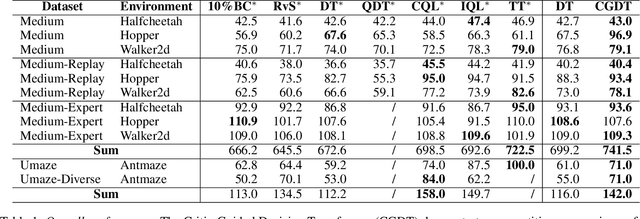


Abstract:Recent advancements in offline reinforcement learning (RL) have underscored the capabilities of Return-Conditioned Supervised Learning (RCSL), a paradigm that learns the action distribution based on target returns for each state in a supervised manner. However, prevailing RCSL methods largely focus on deterministic trajectory modeling, disregarding stochastic state transitions and the diversity of future trajectory distributions. A fundamental challenge arises from the inconsistency between the sampled returns within individual trajectories and the expected returns across multiple trajectories. Fortunately, value-based methods offer a solution by leveraging a value function to approximate the expected returns, thereby addressing the inconsistency effectively. Building upon these insights, we propose a novel approach, termed the Critic-Guided Decision Transformer (CGDT), which combines the predictability of long-term returns from value-based methods with the trajectory modeling capability of the Decision Transformer. By incorporating a learned value function, known as the critic, CGDT ensures a direct alignment between the specified target returns and the expected returns of actions. This integration bridges the gap between the deterministic nature of RCSL and the probabilistic characteristics of value-based methods. Empirical evaluations on stochastic environments and D4RL benchmark datasets demonstrate the superiority of CGDT over traditional RCSL methods. These results highlight the potential of CGDT to advance the state of the art in offline RL and extend the applicability of RCSL to a wide range of RL tasks.
 Add to Chrome
Add to Chrome Add to Firefox
Add to Firefox Add to Edge
Add to Edge